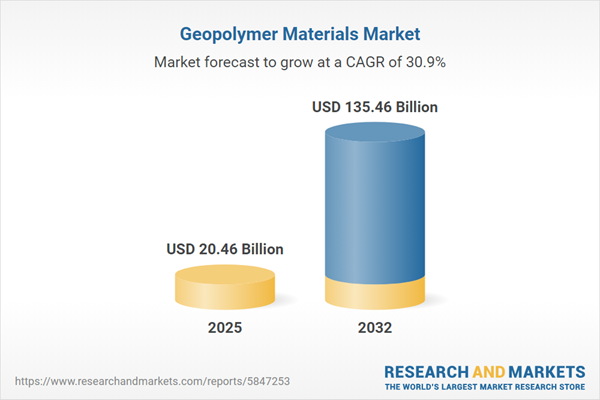Ongoing R&D Activities to Expand Geopolymer in Bone Tissue Applications Presents Opportunities
Speak directly to the analyst to clarify any post sales queries you may have.
Geopolymer materials are rapidly transforming supply chains, offering organizations reliable, sustainable alternatives across critical sectors. They enable businesses to meet evolving regulatory standards while enhancing operational flexibility and resilience.
Market Snapshot: Geopolymer Materials Market Trends and Outlook
The geopolymer materials market is advancing at a remarkable pace. In 2024, its value reached USD 15.69 billion, with continued expansion to USD 20.46 billion projected for 2025. The compound annual growth rate (CAGR) stands at 30.92%, with forecasts pointing to a market size of USD 135.46 billion by 2032. Widespread industry adoption is being driven by the need to boost structural integrity, lower environmental impact, and leverage evolving automation technologies. Industries including construction, automotive, marine, and oil and gas are increasingly integrating geopolymers to meet performance and compliance goals. Regulatory developments and the search for secure, traceable supply chains are propelling the shift to geopolymer solutions worldwide.
Scope & Segmentation of the Geopolymer Materials Market
- Applications: Geopolymer solutions are utilized in automotive parts such as battery enclosures, under-hood systems, commercial and residential buildings, marine engineering coatings, underwater infrastructure, and oil and gas operations including fracturing and pipeline repair. These applications reflect their adaptability to industry-specific challenges and resilience demands.
- Raw Materials: The market uses feedstocks such as fly ash (in various grades), metakaolin, and different types of slag, including ground granulated and synthetic forms. This diversity provides sourcing flexibility, supporting continuity of supply even amid shifting trade dynamics.
- Product Types: Available in liquid activators (e.g., sodium hydroxide and sodium silicate), ready-to-use pastes, and powders suitable for onsite integration or blended binder solutions. These options cater to different manufacturer preferences for deployment and customization.
- End Use Industries: Key sectors include building and construction, chemical processing, energy (oil, gas, power), vital infrastructure (bridges, tunnels), as well as transportation industries like aerospace and rail. This extensive industry reach reinforces their significance to core B2B supply chains.
- Process Types: Both one-part and two-part geopolymerization methods are implemented. Organizations can choose between pre-portioned solutions and custom onsite formulations to meet specific operational requirements.
- Regional Coverage: The market spans the Americas (United States, Canada, Mexico, Brazil, Argentina, Chile, Colombia, Peru), EMEA (United Kingdom, Germany, France, Russia, Italy, Spain), and Asia-Pacific (China, India, Japan, Australia, South Korea, Southeast Asia). Each region brings unique regulatory frameworks and supply conditions, requiring a tailored approach for compliance and responsiveness.
- Leading Companies: Prominent vendors shaping supply chains include BASF SE, Sika AG, Elkem ASA, Wagners Holding Co. Pty Ltd, Zeobond Pty Ltd, CalStar Products, Inc., and Solidia Technologies, Inc.
Key Takeaways for Senior Decision-Makers
- The transition to lower-emission materials is intensifying, with geopolymer binders playing a central role in sustainable construction and manufacturing strategies.
- Partnerships and active industry networks are enhancing transparency and resilience in raw material sourcing, especially for multi-region operators.
- Digital manufacturing and automation are enabling organizations to develop tailored geopolymer formulations for demanding sectors like automotive and marine.
- Integrating alternative feedstocks, such as agricultural residues and synthetic sources, helps organizations manage cost and supply volatility, advancing broader sustainability objectives.
- Strengthening supplier collaborations and focusing on local production support rapid adaptation to shifting policy environments and ensure continuity of operations.
Tariff Impact and Supply Chain Adaptation
Recent tariff changes affecting key raw materials have led organizations to prioritize domestic and regional procurement strategies. Investments in local manufacturing and essential inputs, including sodium silicate, help maintain cost predictability and address logistics obstacles. Firms are focusing on hybrid binder technologies, improved beneficiation processes, and deeper vertical integration to support cost optimization and increased supply chain circularity as global sourcing conditions change.
Methodology & Data Sources
This analysis combines comprehensive secondary research with interviews from sector specialists, technical publications, regulatory analyses, corporate communications, and insights from over 50 experienced practitioners. Senior industry experts validate the findings to ensure quality and relevance.
Why This Report Matters for Stakeholders
- Delivers actionable insights for executives, supporting agile procurement strategies and operational decision-making in a shifting regulatory environment.
- Highlights developments in competitive dynamics, technology, and policy, providing a foundation for fact-based planning and investment decisions.
- Offers clarity on emerging opportunity areas, ensuring leaders remain agile in responding to segmentation and regional market changes.
Conclusion
Geopolymer materials bring organizations new avenues for sustainable growth, innovation, and supply chain adaptation. This report equips senior leaders with insights to inform competitive strategy and shape resilient development agendas.
Additional Product Information:
- Purchase of this report includes 1 year online access with quarterly updates.
- This report can be updated on request. Please contact our Customer Experience team using the Ask a Question widget on our website.
Table of Contents
3. Executive Summary
4. Market Overview
7. Cumulative Impact of Artificial Intelligence 2025
List of Figures
Samples

LOADING...
Companies Mentioned
The key companies profiled in this Geopolymer Materials market report include:- BASF SE
- Sika AG
- Elkem ASA
- Wagners Holding Co. Pty Ltd
- Zeobond Pty Ltd
- CalStar Products, Inc.
- Solidia Technologies, Inc.
Table Information
| Report Attribute | Details |
|---|---|
| No. of Pages | 188 |
| Published | October 2025 |
| Forecast Period | 2025 - 2032 |
| Estimated Market Value ( USD | $ 20.46 Billion |
| Forecasted Market Value ( USD | $ 135.46 Billion |
| Compound Annual Growth Rate | 30.9% |
| Regions Covered | Global |
| No. of Companies Mentioned | 8 |









